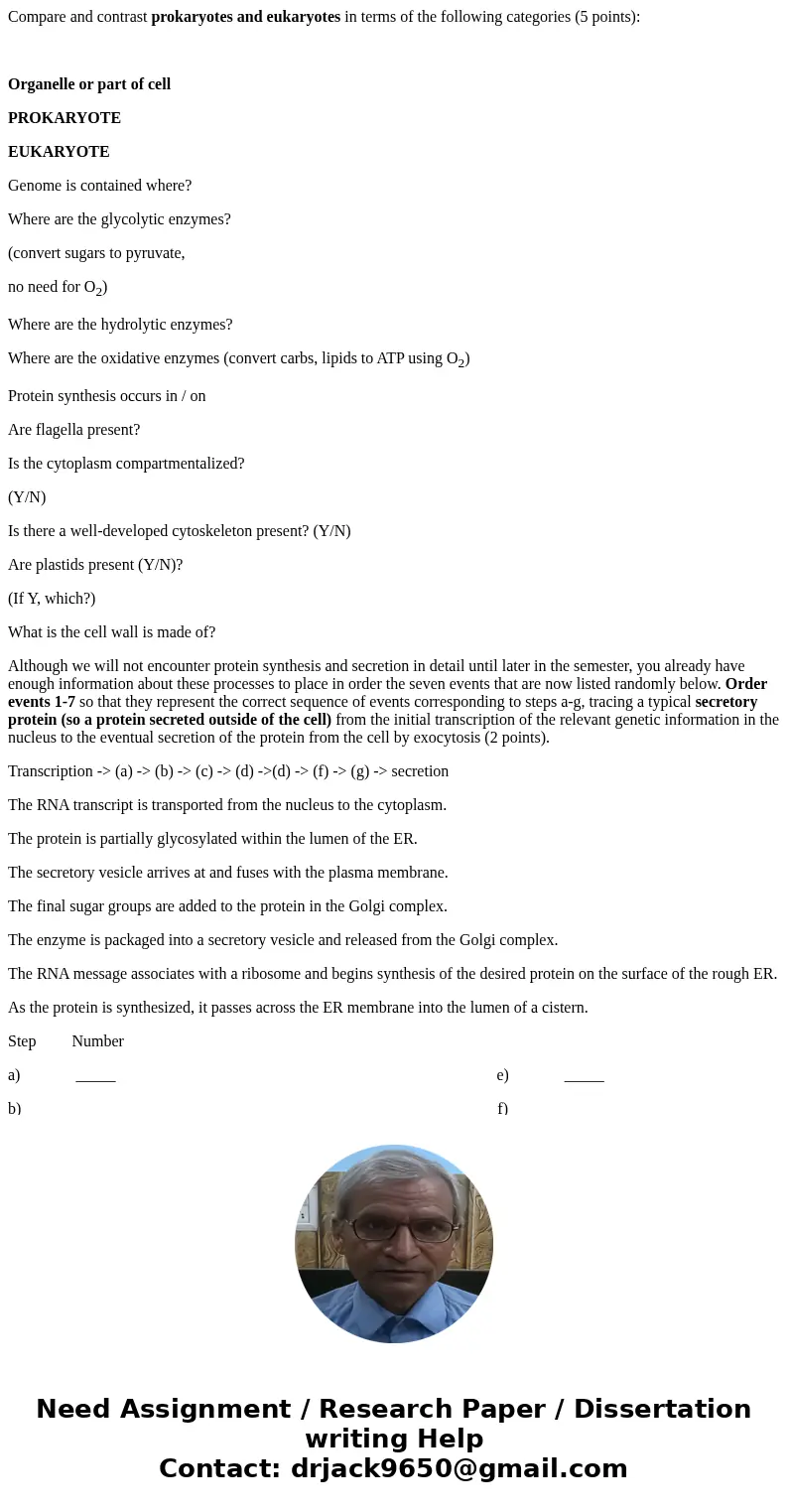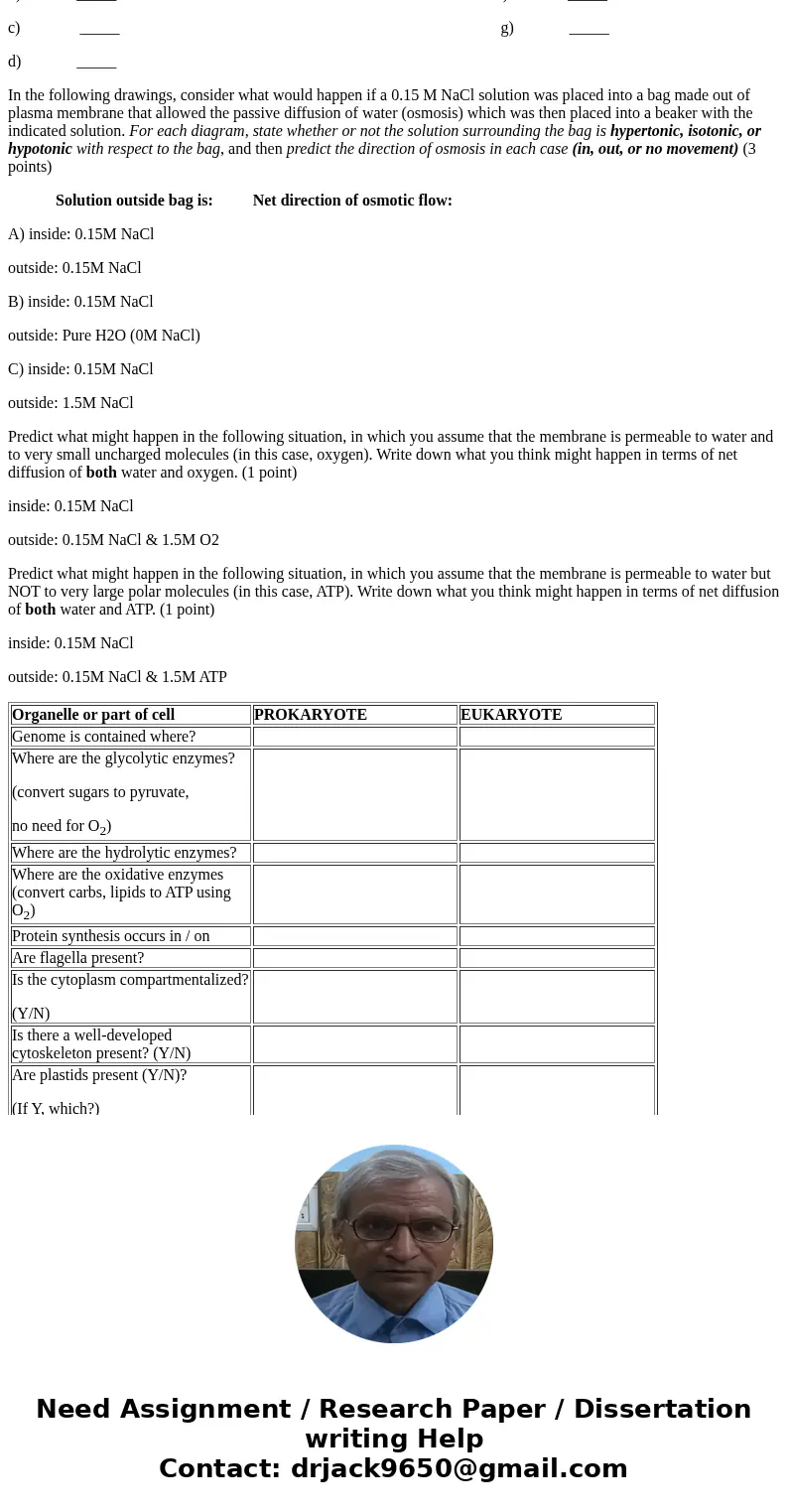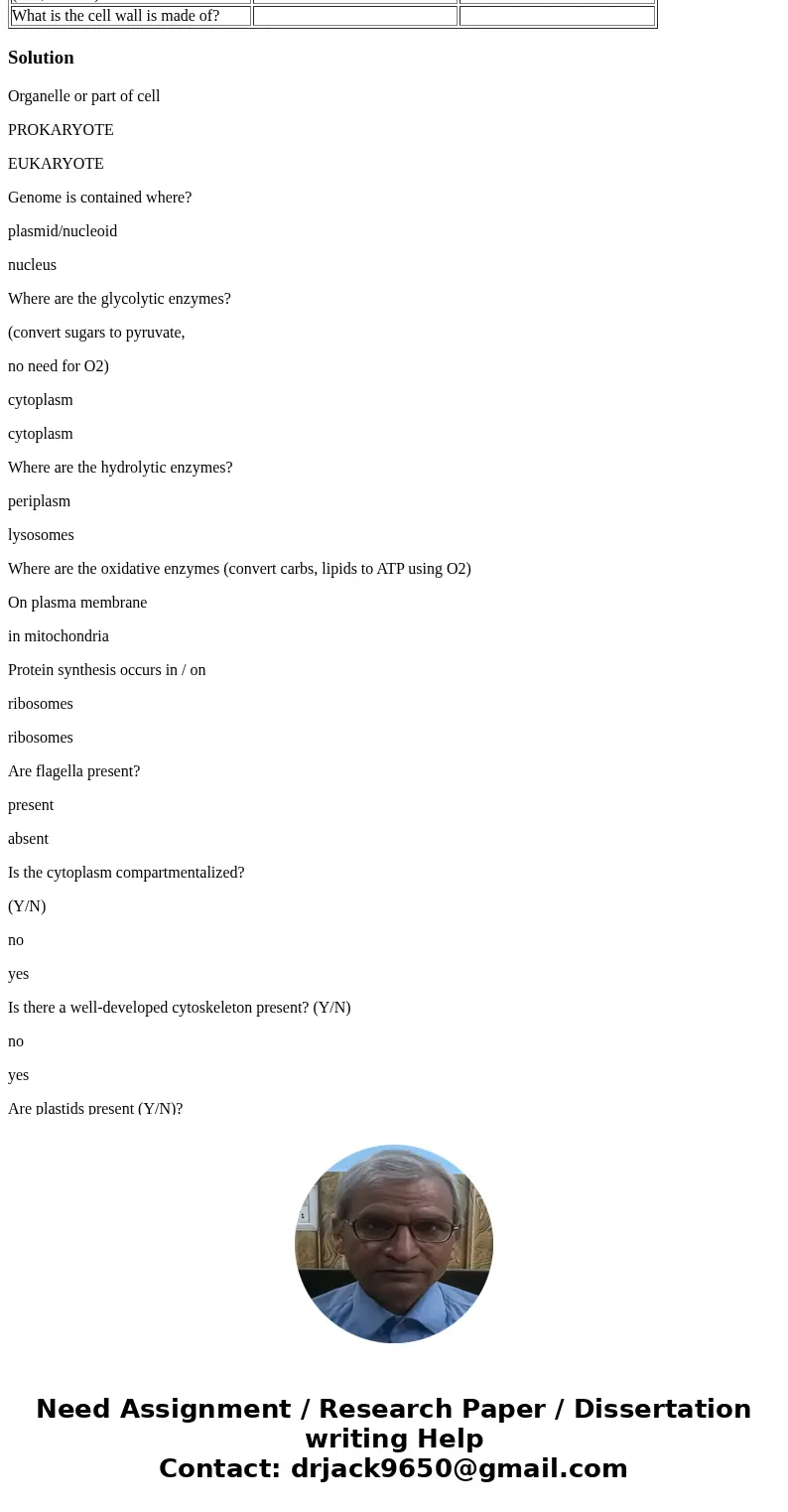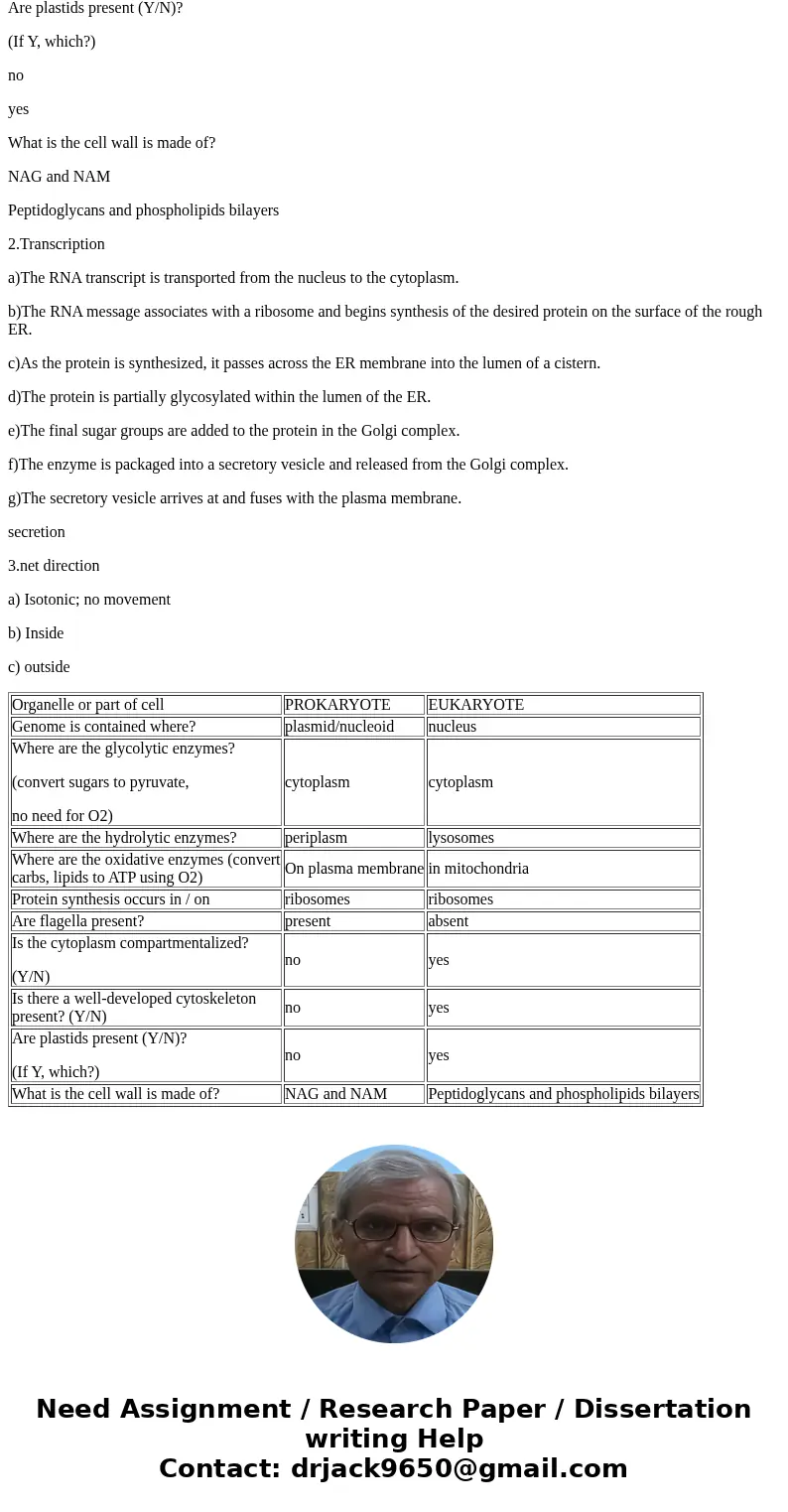Compare and contrast prokaryotes and eukaryotes in terms of
Compare and contrast prokaryotes and eukaryotes in terms of the following categories (5 points):
Organelle or part of cell
PROKARYOTE
EUKARYOTE
Genome is contained where?
Where are the glycolytic enzymes?
(convert sugars to pyruvate,
no need for O2)
Where are the hydrolytic enzymes?
Where are the oxidative enzymes (convert carbs, lipids to ATP using O2)
Protein synthesis occurs in / on
Are flagella present?
Is the cytoplasm compartmentalized?
(Y/N)
Is there a well-developed cytoskeleton present? (Y/N)
Are plastids present (Y/N)?
(If Y, which?)
What is the cell wall is made of?
Although we will not encounter protein synthesis and secretion in detail until later in the semester, you already have enough information about these processes to place in order the seven events that are now listed randomly below. Order events 1-7 so that they represent the correct sequence of events corresponding to steps a-g, tracing a typical secretory protein (so a protein secreted outside of the cell) from the initial transcription of the relevant genetic information in the nucleus to the eventual secretion of the protein from the cell by exocytosis (2 points).
Transcription -> (a) -> (b) -> (c) -> (d) ->(d) -> (f) -> (g) -> secretion
The RNA transcript is transported from the nucleus to the cytoplasm.
The protein is partially glycosylated within the lumen of the ER.
The secretory vesicle arrives at and fuses with the plasma membrane.
The final sugar groups are added to the protein in the Golgi complex.
The enzyme is packaged into a secretory vesicle and released from the Golgi complex.
The RNA message associates with a ribosome and begins synthesis of the desired protein on the surface of the rough ER.
As the protein is synthesized, it passes across the ER membrane into the lumen of a cistern.
Step Number
a) _____ e) _____
b) _____ f) _____
c) _____ g) _____
d) _____
In the following drawings, consider what would happen if a 0.15 M NaCl solution was placed into a bag made out of plasma membrane that allowed the passive diffusion of water (osmosis) which was then placed into a beaker with the indicated solution. For each diagram, state whether or not the solution surrounding the bag is hypertonic, isotonic, or hypotonic with respect to the bag, and then predict the direction of osmosis in each case (in, out, or no movement) (3 points)
Solution outside bag is: Net direction of osmotic flow:
A) inside: 0.15M NaCl
outside: 0.15M NaCl
B) inside: 0.15M NaCl
outside: Pure H2O (0M NaCl)
C) inside: 0.15M NaCl
outside: 1.5M NaCl
Predict what might happen in the following situation, in which you assume that the membrane is permeable to water and to very small uncharged molecules (in this case, oxygen). Write down what you think might happen in terms of net diffusion of both water and oxygen. (1 point)
inside: 0.15M NaCl
outside: 0.15M NaCl & 1.5M O2
Predict what might happen in the following situation, in which you assume that the membrane is permeable to water but NOT to very large polar molecules (in this case, ATP). Write down what you think might happen in terms of net diffusion of both water and ATP. (1 point)
inside: 0.15M NaCl
outside: 0.15M NaCl & 1.5M ATP
| Organelle or part of cell | PROKARYOTE | EUKARYOTE |
| Genome is contained where? | ||
| Where are the glycolytic enzymes? (convert sugars to pyruvate, no need for O2) | ||
| Where are the hydrolytic enzymes? | ||
| Where are the oxidative enzymes (convert carbs, lipids to ATP using O2) | ||
| Protein synthesis occurs in / on | ||
| Are flagella present? | ||
| Is the cytoplasm compartmentalized? (Y/N) | ||
| Is there a well-developed cytoskeleton present? (Y/N) | ||
| Are plastids present (Y/N)? (If Y, which?) | ||
| What is the cell wall is made of? |
Solution
Organelle or part of cell
PROKARYOTE
EUKARYOTE
Genome is contained where?
plasmid/nucleoid
nucleus
Where are the glycolytic enzymes?
(convert sugars to pyruvate,
no need for O2)
cytoplasm
cytoplasm
Where are the hydrolytic enzymes?
periplasm
lysosomes
Where are the oxidative enzymes (convert carbs, lipids to ATP using O2)
On plasma membrane
in mitochondria
Protein synthesis occurs in / on
ribosomes
ribosomes
Are flagella present?
present
absent
Is the cytoplasm compartmentalized?
(Y/N)
no
yes
Is there a well-developed cytoskeleton present? (Y/N)
no
yes
Are plastids present (Y/N)?
(If Y, which?)
no
yes
What is the cell wall is made of?
NAG and NAM
Peptidoglycans and phospholipids bilayers
2.Transcription
a)The RNA transcript is transported from the nucleus to the cytoplasm.
b)The RNA message associates with a ribosome and begins synthesis of the desired protein on the surface of the rough ER.
c)As the protein is synthesized, it passes across the ER membrane into the lumen of a cistern.
d)The protein is partially glycosylated within the lumen of the ER.
e)The final sugar groups are added to the protein in the Golgi complex.
f)The enzyme is packaged into a secretory vesicle and released from the Golgi complex.
g)The secretory vesicle arrives at and fuses with the plasma membrane.
secretion
3.net direction
a) Isotonic; no movement
b) Inside
c) outside
| Organelle or part of cell | PROKARYOTE | EUKARYOTE |
| Genome is contained where? | plasmid/nucleoid | nucleus |
| Where are the glycolytic enzymes? (convert sugars to pyruvate, no need for O2) | cytoplasm | cytoplasm |
| Where are the hydrolytic enzymes? | periplasm | lysosomes |
| Where are the oxidative enzymes (convert carbs, lipids to ATP using O2) | On plasma membrane | in mitochondria |
| Protein synthesis occurs in / on | ribosomes | ribosomes |
| Are flagella present? | present | absent |
| Is the cytoplasm compartmentalized? (Y/N) | no | yes |
| Is there a well-developed cytoskeleton present? (Y/N) | no | yes |
| Are plastids present (Y/N)? (If Y, which?) | no | yes |
| What is the cell wall is made of? | NAG and NAM | Peptidoglycans and phospholipids bilayers |




 Homework Sourse
Homework Sourse